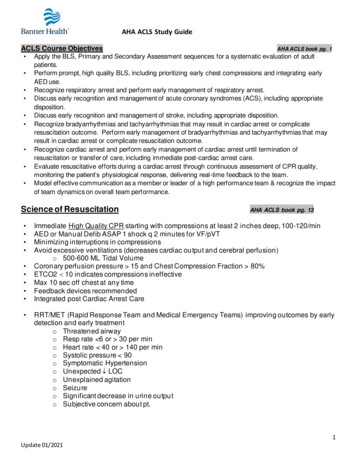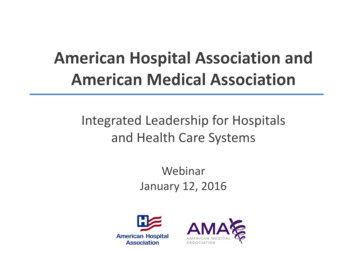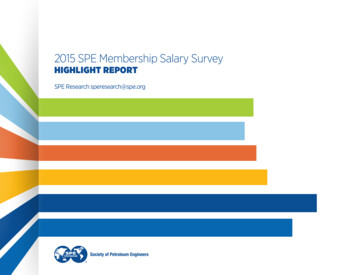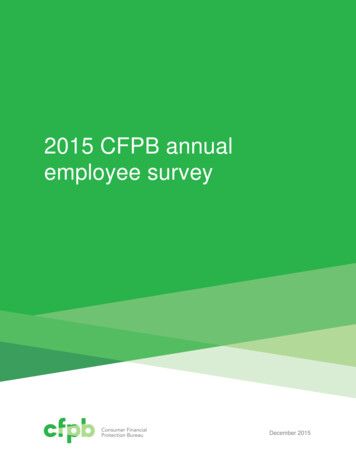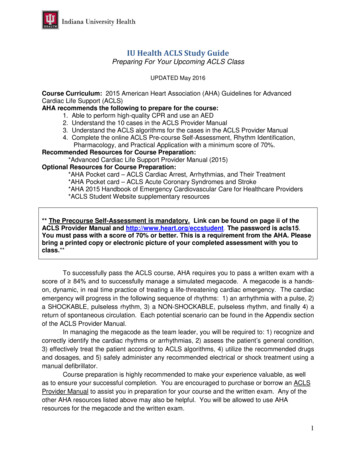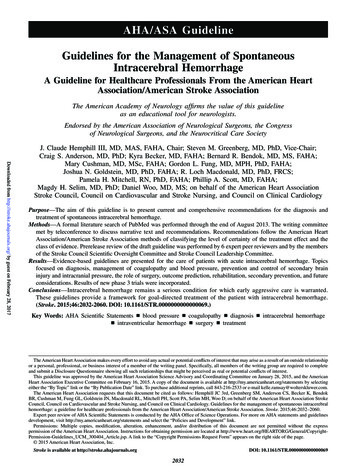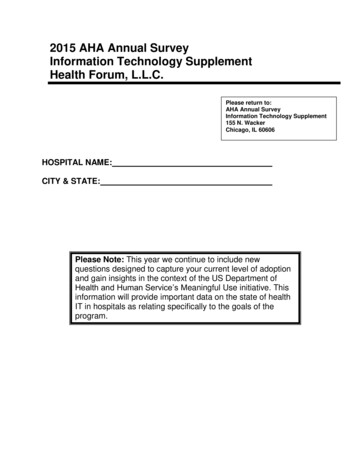
Transcription
2015 AHA Annual SurveyInformation Technology SupplementHealth Forum, L.L.C.Please return to:AHA Annual SurveyInformation Technology Supplement155 N. WackerChicago, IL 60606HOSPITAL NAME:CITY & STATE:Please Note: This year we continue to include newquestions designed to capture your current level of adoptionand gain insights in the context of the US Department ofHealth and Human Service’s Meaningful Use initiative. Thisinformation will provide important data on the state of healthIT in hospitals as relating specifically to the goals of theprogram.
2
GENERAL INSTRUCTIONS: Please respond to each of the following questions as of the day thesurvey is completed.1. Does your hospital currently have a computerized system which allows for:(1)FullyImplementedAcross ALLUnits(2)FullyImplementedin at leastone Unit(3)BeginningtoImplementinat leastone Unit(4)HaveResourcestoImplementin the nextyear(5)Do Not haveResourcesbutConsideringImplementing(6)Not in Placeand NotConsideringImplementinga. Patient demographics b. Physician notes c. Nursing notes d. Problem lists e. Medication lists f. Discharge summaries g. Advanced directives (e.g. DNR) a. Laboratory reports b. Radiology reports c. Radiology images (Fully implemented means it hascompletely replaced paper record forthe function.)Electronic Clinical documentationResults Viewingd. Diagnostic test results (e.g.EKG report, Echo report)e. Diagnostic test images (e.g.EKG tracing)f. Consultant reportsComputerized Provider Order Entry (Provider (e.g., MD, APN, NP) directly enters own orders that are transmitted electronically)a. Laboratory tests b. Radiology tests c. Medicationsd. Consultation requestse. Nursing orders3
(1)FullyImplementedAcross ALLUnits(2)FullyImplementedin at leastone Unit(3)BeginningtoImplementinat leastone Unit(4)HaveResourcestoImplementin the nextyear(5)Do Not haveResourcesbutConsideringImplementing(6)Not in Placeand NotConsideringImplementing c. Drug allergy alerts d. Drug-drug interaction alerts e. Drug-lab interaction alerts (Fully implemented means it hascompletely replaced paper record forthe function.)Decision Supporta. Clinical guidelines (e.g. Betablockers post-MI, ASA in CAD)b. Clinical reminders (e.g.pneumovax)f. Drug dosing support (e.g. renaldose guidance)Bar Coding or Radio Frequency Identification (RFID) for Closed-loop Medication Trackinga. Medication administration b. Patient verification b. Telehealth c. Remote patient monitoring d. Ability to connect mobile devices c. Caregiver verificationd. Pharmacy verificationOther Functionalitiesa. Bar coding or Radio Frequency(RFID) for supply chainmanagement(tablet, smart phone, etc.) to EHR4
Meaningful Use Functionalities2. Does your hospital currently have a computerized system which allows for:Electronic Clinical Documentation & Population Health Managementa. Record patient demographics, including race, ethnicity and preferred languageb. Identify and provide patient-specific education resourcesYesNoDo NotKnow Medication Managementa. Compare a patient’s inpatient and preadmission medication listsb. Check inpatient prescriptions against an internal formularyc. Prescribe (eRx) discharge medication orders electronicallyd. Provide an updated medication list at time of dischargeCare Summary Documentsa. Generate summary of care record for relevant transitions of careb. Send summary of care records to an unaffiliated organization using a different certifiedEHR vendorAutomated Quality Reportinga. Automatically generate hospital-specific meaningful use quality measures by extractingdata from an EHR without additional manual processesb. Automatically generate Medicare Inpatient Quality Reporting program measures for a fullMedicare inpatient updatec. Automatically generate physician-specific meaningful use quality measures calculateddirectly from the EHR without additional manual processesPublic Health Reportinga. Submit electronic data to immunization registries/information systems on an ongoing basisper meaningful use standardsb. Submit electronic data on reportable lab results to public health agencies on an ongoingbasis per meaningful use standardsc. Submit electronic syndromic surveillance data to public health agencies on an ongoingbasis per meaningful use standardsd. Submit specialized data registry reports to public health agencies on an ongoing basis permeaningful use standardsOther Functionalitiesa. Implement at least 5 Clinical Decision Support interventions related to 4 or more clinicalquality measuresb. Conduct or review a security risk analysis and implement security updates as necessary5
3. Are patients treated in your hospital able to do the following:YesNoDo Not Knowa.View their health/medical information online b.Download information from their health/medical record c.Electronically transmit (send) transmission of care/referral summaries to athird party d.Request an amendment to change/update their health/medical record e.Request refills for prescriptions online f.Schedule appointments online g.Pay bills online h.Submit patient-generated data (e.g., blood glucose, weight) i.Secure messaging with providers j.Designate family member or caregiver to access information on behalf of thepatient (e.g., proxy access) 6
Health Information Exchange Functionalities4. Which of the following patient data does your hospital electronically exchange/share with one or more of theprovider types listed below? (Check all that apply)a.Patient demographicsb.Laboratory resultsc.Medication historyd.Radiology reportse.Clinical/Summary care record inany formatWithHospitalsInside ofYour SystemWithHospitalsOutside ofYourSystemWithAmbulatoryProvidersInside ofYour SystemWithAmbulatoryProvidersOutside ofYour SystemDo NotKnow This next section asks further detail about sending and/or receiving summary care records.5. When a patient transitions to another care setting or organization outside your hospital system, how does yourhospital routinely send and/or receive a summary of care record? Check all that apply.a.Mail or faxb.eFax using EHRc.Secure messaging using EHR (via DIRECT orother secure protocol)Provider portal (i.e., post to portal or downloadfrom portal)Via health information exchange organization orother third partyd.e.SendReceive Neithersend norreceive Do notknow 6. When a patient transitions to or from another care setting or organization, does your hospital routinelyelectronically send and/or receive (NOT eFax) a summary of care record in a structured format (e.g. CCR, CCDA,or CCD) with the following providers? Check all that apply.a.Other Hospitals outside your systemb.Ambulatory Care Providers outside your systemc.Long-term and Post-Acute Care Providers (inside or outsideyour system)d.Behavioral Health Providers (inside or outside your system)SendReceiveNeither sendnor receiveDo not know 7. Does your EHR integrate any type of clinical information received electronically (not eFax) from providers orsources outside your hospital system/organization without the need for manual entry? This could be done usingsoftware to convert scanned documents into indexed, discrete data that can be integrated into EHR. Yes, routinely Yes, but not routinely No7 Do not know NA
8. If yes, does your EHR integrate the information contained in summary of care records received electronically (noteFax) without the need for manual entry? This could be done using software to convert scanned documents intoindexed, discrete data that can be integrated into EHR. Yes, routinely Yes, but not routinely No Do not know NAThis next section asks further detail about other aspects of exchange and interoperability.9. Do providers at your hospital query electronically for patients’ health information (e.g. medications, outsideencounters) from sources outside of your organization or hospital system? Yes No, but do have the capability No, don’t have capability Do not know10. Do providers at your hospital routinely have necessary clinical information available electronically (not e-Fax)from outside providers or sources when treating a patient that was seen by another health care provider/setting? Yes No Do not know11a. How frequently do providers at your hospital use patient health information received electronically (not e-Fax)from outside providers or sources when treating a patient? Often Sometimes Rarely Never Don’t know11b. If rarely or never used, please indicate the reason(s) why. Check all that apply.5. Information not always available when needed (e.g. not timely) Do not trust accuracy of information Difficult to integrate information in EHR Information not available to view in EHR as part of clinicians’ workflow Information not presented in a useful format (e.g. too much information, redundant, or6.unnecessaryinformation)7. Other1.2.3.4.12a. When a patient visits your Emergency Department (ED), do you routinely provide electronic notification to thepatient’s primary care physician? Yes No, but do have the capability No, don’t have capability Do Not Know Do Not Have ED12b. If yes, are electronic notifications provided to primary care physicians below? (Check all that apply) Inside System Outside System Do Not Know13. Please indicate your level of participation in a state, regional, and/or local health information exchange (HIE) orhealth information organization (HIO).a. HIE/HIO is operational in my area and we are participating and actively exchanging data in at least oneHIE/RHIOb.c.d. HIE/HIO is operational in my area but we are not participating HIE/HIO is not operational in my area Do not know8
This next section asks about barriers to exchange and interoperability.14. Which of the following issues has your hospital experienced when trying to electronically (not eFax) send,receive or find (query) patient health information to/from other care settings or organizations?(Check all that apply)a. We lack the technical capability to electronically send patient health information to outside providers or othersourcesb. We lack the technical capability to electronically receive patient health information from outside providers orother sourcesc. Providers we would like to electronically send patient health information to, do not have an EHR or otherelectronic system with capability to receive the informationd. Providers we would like to electronically send patient health information to have an EHR; however, it lacks thetechnical capability to receive the information Many recipients of our electronic care summaries (e.g. CCDA) report that the information is not usefulf. Cumbersome workflow to send (not eFax) the information from our EHR systemg. Difficult to match or identify the correct patient between systemsh. Difficult to locate the address of the provider to send the information (e.g. lack of provider directory)i. Experience greater challenges exchanging (e.g. sending/receiving data) across different vendor platformsj. We don’t typically share our patient data with care settings/organizations outside our systemk. We have to pay additional costs to send/receive data with care settings/organizations outside our systeme.If 14k is yes, please indicate the source(s) of those additional costs below (check all that apply)1.2.3.4. Your EHR vendor The recipient’s EHR vendor An intermediary that enables the sending or receiving of data (e.g. HISP, HIE, Direct Trust, NATE) Other source not listed above:9
EHR System and IT Vendors15. Does your IT Department currently support an infrastructure for two factor authentication (e.g. tokens orbiometrics)? Yes No Do not know16. Do you possess an EHR system that has been certified as meeting federal requirements for the hospitalobjectives of Meaningful Use? Yes No Do not know17. On the whole, how would you describe your EMR/EHR system?a.b.c. A mix of products from different vendors Primarily one vendor Self-developed18a. Which vendor below provides your primary inpatient EMR/EHR system? (Please check only one)“Primary” is defined as the system that is used for the largest number of patients or the system in which you have madethe single largest investment. Please answer based on vendor name rather than product. Allscripts/Eclipsys CPSI Cerner NextGen Epic GE HMS Healthland McKesson Meditech QuadraMed Vitera/Greenway Siemens Self-developed Other (please specify) Would prefer not to disclose18b. Do you use the same primary inpatient EHR/EMR system vendor (noted above) for your primary outpatientEMR/EHR system? “Primary” is defined as the system that is used for the largest number of patients or the systemin which you have made the single largest investment. Please answer based on vendor name rather than product. Yes No Do not Know NA19. Which vendor(s) below does your hospital directly use to electronically exchange patient healthinformation? (Please check all that apply) The same system as our primary inpatient EMR/EHR system (noted above) MedFX Intersystems Harris Surescripts Medicity Truven Analytics Mirth Relay Health Orion Health Inpriva Care Evolution Optom/Axolotl MaxMD Covinst Sandlot ICA MedAllies Microsoft Certify Data Systems Other (please specify) Do not exchange patient health information electronically Would prefer not to disclose10
20. What changes, if any, are you planning for your primary inpatient EMR/EHR system within the next 18 months?(Please check all that apply)a.b.c.d.e.f.g. Initial deployment Major change in vendor Change from enterprise architecture to best-of-breed Change from best-of-breed to enterprise architecture Significant additional functionalities Do not know No major changes planned21. What is (are, or would be) the primary challenge(s) in implementing an EMR/EHR system that meets thefederal requirements for meaningful use? (Please check all that apply)a.b.c.d.e.f.g.h.i.j. Upfront capital costs/lack of access to capital to install systems Ongoing cost of maintaining and upgrading systems Obtaining physician cooperation Obtaining other staff cooperation Concerns about security or liability for privacy breaches Uncertainty about certification requirements Limited vendor capacity Lack of adequate IT personnel in hospital to support implementation/maintenance Challenge/complexity of meeting all meaningful use criteria within implementation timeframe Other (specify)22. Please indicate whether you have used electronic clinical data from the EHR or otherelectronic system in your hospital to: (Please check all that apply)a.b.c.d.e.f.g.h.i.j.k. Create a dashboard with measures of organizational performance Create a dashboard with measures of unit-level performance Create individual provider performance profiles Create an approach for clinicians to query the data Assess adherence to clinical practice guidelines Identify care gaps for specific patient populations Generate reports to inform strategic planning Support a continuous quality improvement process Monitor patient safety (e.g., adverse drug events) Identify high risk patients for follow-up care using algorithm or other tools None of the above11
DefinitionsQuestion 2 - Summary Care Record The Centers for Medicare & Medicaid Services (CMS) define atransition of care as the movement of a patient from one setting of care (hospital, ambulatory primary carepractice, ambulatory, specialty care practice, long-term care, home health, rehabilitation facility) toanother. The federal regulation for Meaningful Use specifies that for more than 50 percent of transitions ofcare or referrals, eligible hospitals must provide a summary care record using specified vocabulary,clinical documentation, and transmission standards and including, at a minimum, diagnostic tests results,problem list, medication list, and medication allergy list.Question 4 – Electronic Exchange Electronic exchange of patient healthcare information refers toexchanging of data through non-manual means, such as EHRs and/or portals, and excludes fax/paper.Question 4 – Inside/Outside System Hospitals and ambulatory providers inside your system refer tothose affiliated with your integrated delivery system/network. Hospitals and ambulatory providers outsideyour system refer to those unaffiliated with your integrated delivery system/network.Question 6 – Continuous Care Records (CCR) Continuous care record standard enables a patienthealth summary to be created, read, and interpreted by any EHR/EMR software application.Question 6 – Continuous Clinical Document Architecture (CCDA) Continuous document architectureis an XML-based markup standard intended to specify the encoding, structure, and semantic of clinicaldocument for exchange.Question 6 – Continuous Care Documentation (CCD) Continuous care documentation is an HL7Clinical Document Architecture implementation of the Continuous Care Record.Thank you for your cooperation in completing this survey. If you are not the CIO or person responsible forinformation technology, has he or she reviewed your answers to this survey? Yes NoRespondent Name (please print) Circle CIO or Print Title if other/ /Date of CompletionName of CIO (if other than respondent)(Area Code) Telephone #Email AddressNOTE: PLEASE PHOTOCOPY THIS INFORMATION FOR YOUR HOSPITAL FILE BEFORERETURNING THE ORIGINAL FORM TO THE AMERICAN HOSPITAL ASSOCIATION.THANK YOU12
2015 AHA Annual Survey Information Technology Supplement Health Forum, L.L.C. HOSPITAL NAME: . Does your EHR integrate any type of clinical information received electronically (not eFax) from providers or . EHR System and IT Vendors 15. Does your IT Department currently support an infrastructure for two factor authentication (e.g. tokens or
